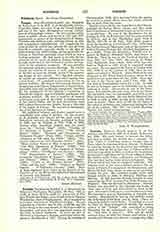

Pounde, THOMAS, lay brother, b. at Beaumond (or Belmont), Farlington, Hampshire, May 29, 1538 or 1539; d. there, February 26, 1612-13; eldest son of William Pounde and Helen, sister or half-sister to Thomas Wriothesley, Earl of Southampton. He is reported to have been educated at Winchester College. He was admitted to Lincoln’s Inn February 16, 1559-60, and his father dying in the same month, he then succeeded to Beaumond, and soon after was appointed esquire of the body to Queen Elizabeth. He acted the part of Mercury in Gascoigne’s Masque, performed before the queen at Kenilworth in 1565. During the revelries of Christmastide, 1569, after dancing before the queen, he received a public affront from her, which induced him to retire from the court.
Shortly afterwards he was reconciled to the Church, probably by Father Henry Alway, and after some time of seclusion at Beaumond, began an active career as proselytizer. He was in the Marshalsea for six months in 1574; in Winchester Gaol for some months in 1575-6; and in the Marshalsea again from March 9, 1575-76, to September 18, 1580, being made a Jesuit lay-brother by a letter dated December 1, 1578, from the Father-General Mercurian, sent at the instance of Father Thomas Stevens, S.J., the first Englishman to go to India. From the Marshalsea Pounde was removed to Bishop‘s Stortford Castle, and thence to Wisbech. Then he was in the Tower of London August 13, 1581, to December 7, 1585. He was in the White Lion, Southwark, from September 1, 1586, till he was sent back to Wisbech in 1587, where he remained nearly ten years. He was again in the Tower of London from February, 1596-7, to the autumn of 1598, when he was again committed to Wisbech. From Wisbech he was relegated to the Wood Street Counter, where he remained for six weeks from December 19, 1598. After that he was in the Tower again until July 7, 1601. He was then in Framlingham Castle for a year. In 1602 he was in Newgate, and in the following year he was indicted at York. Afterwards he was in the Gatehouse, Westminster, for some time, then in the Tower (for the fourth time) for four months, and lastly in the Fleet for three months. He was finally liberated late in 1604 or early in 1605, having spent nearly thirty years in prison. These facts are but the dry bones of the career of an heroic man, whose real biography has yet to be written. The “life” by Father Matthias Tanner, S.J., is full of inaccuracies.
JOHN B. WAINEWRIGHT

